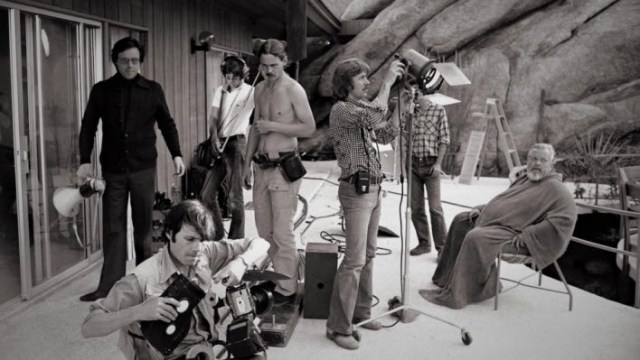
As many of you know, Orson Welles’ filmmaking career was full of frustrations and disappointments. Although he drew lots of attention when he made his first feature film “Citizen Kane” (1941), it took many years for that film to be recognized as one of the greatest works in the film history, and many of his subsequent works were hampered by numerous production problems. While his very next film “The Magnificent Ambersons” (1942) was severely butchered after a poor test screening result, “Touch of Evil” (1958) was also heavily modified despite his protest, and his other notable works including “Chimes at Midnight” (1965) were frequently riddled with financial troubles during their production.
In case of “The Other Side of the Wind” (2018), it was one of Welles’ several unfinished film projects, but it was recently completed after the legal matters surrounding it were finally resolved a few years ago, and Netflix documentary film “They’ll Love Me When I’m Dead” looks into its fascinating production story. While feeling a bit uneven at times as trying to show and tell a lot of things for 98 minutes, but the documentary is still interesting on the whole, and I certainly become more interested in watching “The Other Side of the Wind”, which is incidentally released along with the documentary on Netflix.
In the beginning, the movie gives us some background information on how Welles came to decide to try a comeback around the early 1970s. Although he has been far less welcomed by Hollywood since the commercial failure of “Touch of Evil”, Hollywood was going through a major change at that time through the rise of new American films represented by “Bonny and Clyde” (1967) and “Easy Rider” (1969), and Welles was willing to try something different just like those young promising filmmakers during that era. Not long after he returned to Hollywood, he was approached by Gary Graver, a young cinematographer who was quite eager to work with him, and that was his first step toward “The Other Side of the Wind”.

Welles soon began to write the screenplay for “The Other Side of the Wind” along with a young Croatian actress named Oja Kodar, who was his lover during that time and also came to play the lead actress of a movie within in the film. The hero of “The Other Side of the Wind” is an aging Hollywood filmmaker who has struggled to complete his last film, and it was clear to everyone that the hero of the story was more or less than the fictional version of Welles himself, but he repeatedly denied that in public, even though he seemed to enjoy how others speculated about his film.
While he did not have enough money for the production of “The Other Side of the Wind”, Welles was confident as usual. In fact, he started to shoot one of its major sequences along with his few crew members including Graver and a bunch of performers including Claude Chabrol and Dennis Hopper, who was not exactly in an ideal condition for the shooting due to his drug addiction but managed to perform in front of the camera anyway.
Welles shot this sequence even though he had not yet cast anyone as the lead actor of his movie. While he considered casting himself as the lead actor, he was already determined to hire someone as big and legendary as himself, and that was none other than his old friend John Huston, who did not hesitate at all when Welles called him. Once Huston joined the shooting, things looked more promising than before as reflected by a number of behind-the-scene footage clips shown in the documentary, and it seemed Welles was really going to accomplish something new and great as he once did many years ago.
However, the production of “The Other Side of the Wind” soon came to face a series of troubles, and its production process became a lot longer than expected. While the financers of the movie understandably got nervous, Welles kept changing the screenplay during the shooting, and everyone else on the set was not so sure about what exactly Welles and they were doing. Even Huston became frustrated in the end, and he had some private talk with Welles in the end not long before he left for making “The Man Who Would Be King” (1975).

In case of Graver, Welles demanded a lot from him, and the documentary tells us a bit about how much Graver was devoted to making “The Other Side of the Wind”. Not paid well during the production, Graver even shot a number of pornography films for making ends meet, but he remained loyal to Welles nonetheless, and there is a poignant archival footage clip showing his considerable dedication to “The Other Side of the Wind”.
Eventually, the principal photography of “The Other Side of the Wind” was ended in 1976, and Welles moved onto the editing step, but, alas, the movie was subsequently thrown into a legal limbo due to his conflict with his financers. Before he died in 1985, Welles tried as much as he could for saving his film, but he miserably failed, and we are reminded again that he was often his worst enemy in his many problematic circumstances.
“They’ll Love Me When I’m Dead” is directed by Morgan Neville, who won an Oscar for “20 Feet from Stardom” (2013) and previously made “Best of Enemies” (2015). Compared to these two previous works of his, it is less impressive in my trivial opinion, but Neville did a competent job of mixing interviews and archival photographs and footage clips, and it certainly deserves to be watched along with “The Other Side of the Wind”.


![Lake Dillon and a Tree [In Explore] Lake Dillon and a Tree [In Explore]](https://live.staticflickr.com/65535/53731226172_4004cbfea4_s.jpg)




